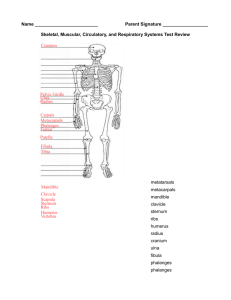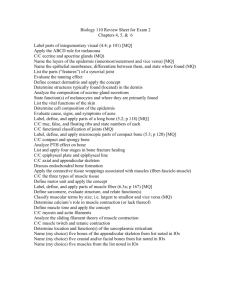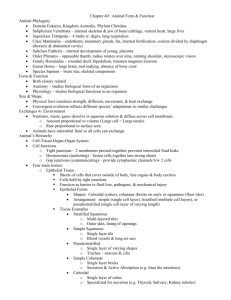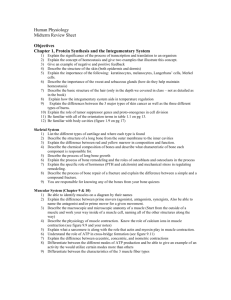Section 46-1
advertisement
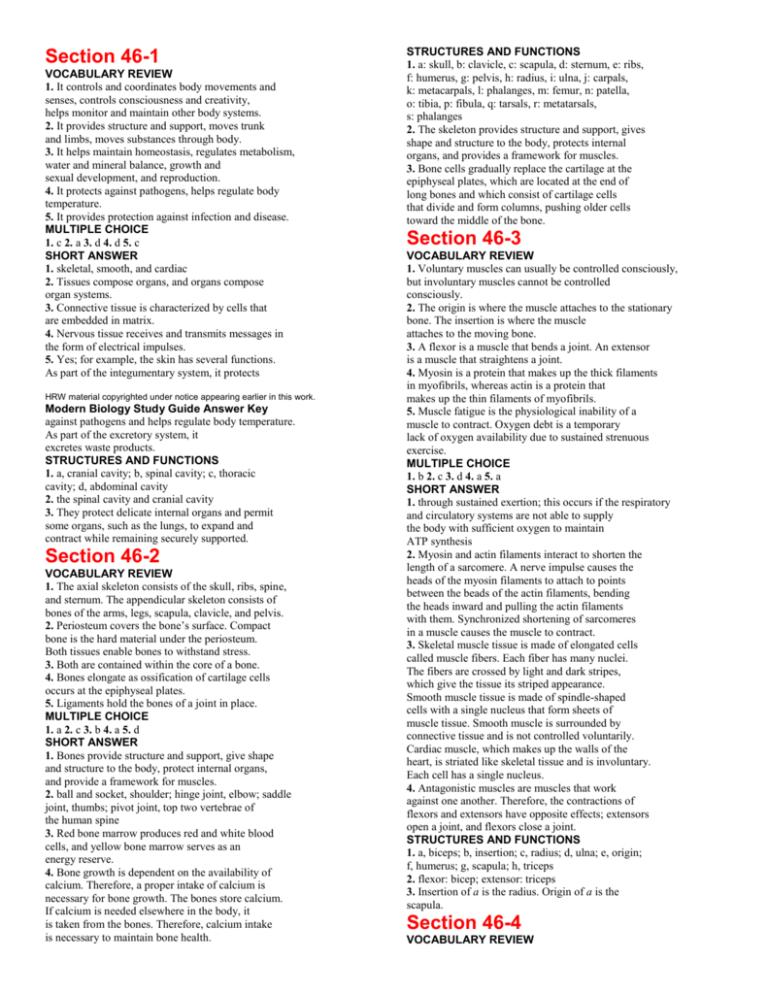
Section 46-1 VOCABULARY REVIEW 1. It controls and coordinates body movements and senses, controls consciousness and creativity, helps monitor and maintain other body systems. 2. It provides structure and support, moves trunk and limbs, moves substances through body. 3. It helps maintain homeostasis, regulates metabolism, water and mineral balance, growth and sexual development, and reproduction. 4. It protects against pathogens, helps regulate body temperature. 5. It provides protection against infection and disease. MULTIPLE CHOICE 1. c 2. a 3. d 4. d 5. c SHORT ANSWER 1. skeletal, smooth, and cardiac 2. Tissues compose organs, and organs compose organ systems. 3. Connective tissue is characterized by cells that are embedded in matrix. 4. Nervous tissue receives and transmits messages in the form of electrical impulses. 5. Yes; for example, the skin has several functions. As part of the integumentary system, it protects 38 HRW material copyrighted under notice appearing earlier in this work. Modern Biology Study Guide Answer Key against pathogens and helps regulate body temperature. As part of the excretory system, it excretes waste products. STRUCTURES AND FUNCTIONS 1. a, cranial cavity; b, spinal cavity; c, thoracic cavity; d, abdominal cavity 2. the spinal cavity and cranial cavity 3. They protect delicate internal organs and permit some organs, such as the lungs, to expand and contract while remaining securely supported. Section 46-2 VOCABULARY REVIEW 1. The axial skeleton consists of the skull, ribs, spine, and sternum. The appendicular skeleton consists of bones of the arms, legs, scapula, clavicle, and pelvis. 2. Periosteum covers the bone’s surface. Compact bone is the hard material under the periosteum. Both tissues enable bones to withstand stress. 3. Both are contained within the core of a bone. 4. Bones elongate as ossification of cartilage cells occurs at the epiphyseal plates. 5. Ligaments hold the bones of a joint in place. MULTIPLE CHOICE 1. a 2. c 3. b 4. a 5. d SHORT ANSWER 1. Bones provide structure and support, give shape and structure to the body, protect internal organs, and provide a framework for muscles. 2. ball and socket, shoulder; hinge joint, elbow; saddle joint, thumbs; pivot joint, top two vertebrae of the human spine 3. Red bone marrow produces red and white blood cells, and yellow bone marrow serves as an energy reserve. 4. Bone growth is dependent on the availability of calcium. Therefore, a proper intake of calcium is necessary for bone growth. The bones store calcium. If calcium is needed elsewhere in the body, it is taken from the bones. Therefore, calcium intake is necessary to maintain bone health. STRUCTURES AND FUNCTIONS 1. a: skull, b: clavicle, c: scapula, d: sternum, e: ribs, f: humerus, g: pelvis, h: radius, i: ulna, j: carpals, k: metacarpals, l: phalanges, m: femur, n: patella, o: tibia, p: fibula, q: tarsals, r: metatarsals, s: phalanges 2. The skeleton provides structure and support, gives shape and structure to the body, protects internal organs, and provides a framework for muscles. 3. Bone cells gradually replace the cartilage at the epiphyseal plates, which are located at the end of long bones and which consist of cartilage cells that divide and form columns, pushing older cells toward the middle of the bone. Section 46-3 VOCABULARY REVIEW 1. Voluntary muscles can usually be controlled consciously, but involuntary muscles cannot be controlled consciously. 2. The origin is where the muscle attaches to the stationary bone. The insertion is where the muscle attaches to the moving bone. 3. A flexor is a muscle that bends a joint. An extensor is a muscle that straightens a joint. 4. Myosin is a protein that makes up the thick filaments in myofibrils, whereas actin is a protein that makes up the thin filaments of myofibrils. 5. Muscle fatigue is the physiological inability of a muscle to contract. Oxygen debt is a temporary lack of oxygen availability due to sustained strenuous exercise. MULTIPLE CHOICE 1. b 2. c 3. d 4. a 5. a SHORT ANSWER 1. through sustained exertion; this occurs if the respiratory and circulatory systems are not able to supply the body with sufficient oxygen to maintain ATP synthesis 2. Myosin and actin filaments interact to shorten the length of a sarcomere. A nerve impulse causes the heads of the myosin filaments to attach to points between the beads of the actin filaments, bending the heads inward and pulling the actin filaments with them. Synchronized shortening of sarcomeres in a muscle causes the muscle to contract. 3. Skeletal muscle tissue is made of elongated cells called muscle fibers. Each fiber has many nuclei. The fibers are crossed by light and dark stripes, which give the tissue its striped appearance. Smooth muscle tissue is made of spindle-shaped cells with a single nucleus that form sheets of muscle tissue. Smooth muscle is surrounded by connective tissue and is not controlled voluntarily. Cardiac muscle, which makes up the walls of the heart, is striated like skeletal tissue and is involuntary. Each cell has a single nucleus. 4. Antagonistic muscles are muscles that work against one another. Therefore, the contractions of flexors and extensors have opposite effects; extensors open a joint, and flexors close a joint. STRUCTURES AND FUNCTIONS 1. a, biceps; b, insertion; c, radius; d, ulna; e, origin; f, humerus; g, scapula; h, triceps 2. flexor: bicep; extensor: triceps 3. Insertion of a is the radius. Origin of a is the scapula. Section 46-4 VOCABULARY REVIEW 1. Acne is a skin disorder caused by clogged oil gland ducts. 2. Melanin is a pigment produced by cells in the lower layers of the epidermis. 3. Sebum is a fatty substance secreted by oil glands that helps soften and waterproof skin. 4. Keratin is a protein in skin, hair, and nails. 5. Sweat glands function as excretory organs through the release of excess water, salts, and urea. They regulate body temperature by releasing sweat, which cools the body when it evaporates. MULTIPLE CHOICE 1. c 2. b 3. a 4. b 5. c SHORT ANSWER 1. It is a barrier that protects the body, retains body fluid, protects against disease, eliminates waste products, and regulates body temperature. 39 HRW material copyrighted under notice appearing earlier in this work. Modern Biology Study Guide Answer Key 2. It causes skin damage, which causes an increase in melanin production. 3. The epidermis is the outer barrier of the skin and is the first defense against disease, water loss, and ultraviolet radiation damage. 4. Both have clusters of root or base cells, contain dead cells, and have cells that are filled with keratin. 5. Concentrated melanin production in certain areas of the skin causes moles and freckles. STRUCTURES AND FUNCTIONS 1. a, epidermis; b, dermis; c, muscle fibers; d, blood vessel; e, oil gland; f, pore; g, hair; h, hair follicle; i, sweat gland 2. The epidermis and hair contain keratin. 3. The dermis contains various kinds of sensory neurons that respond to heat and pressure. Section 47-1 VOCABULARY REVIEW 1. Each side of the heart is divided into an upper chamber (an atrium) and a lower chamber (a ventricle). 2. The sinoatrial node and the atrioventricular node produce electrical impulses that cause cardiac muscles to contract during a heartbeat. 3. Systolic pressure is the amount of blood pressure that occurs when the ventricles contract, and diastolic pressure is the amount of blood pressure that occurs when the ventricles relax. 4. The arterioles are small blood vessels that branch into tiny vessels called capillaries. Blood flows through capillaries that merge to form larger vessels called venules. MULTIPLE CHOICE 1. b 2. d 3. b 4. c 5. b SHORT ANSWER 1. In pulmonary circulation blood circulates between the heart and lungs. In systemic circulation blood circulates throughout the body. 2. Deoxygenated blood moves from the right atrium to the right ventricle and then to the lungs. Oxygenated blood returns from the lungs to the left atrium and then moves into the left ventricle. Oxygenated blood is pumped from the left ventricle and circulates throughout the body. Deoxygenated blood returns to the right atrium. 3. It returns fluids that have collected in the tissues to the bloodstream. It also traps foreign particles, microorganisms, and other tissue debris. 4. Diastolic; if blood flowed back into the left ventricle after contraction, less blood would remain in the arteries, reducing the blood pressure when the heart is relaxed. STRUCTURES AND FUNCTIONS 1. a: aorta, b: superior vena cava, c: right atrium, d: tricuspid valve, e: right ventricle, f: inferior vena cava, g: pulmonary artery, h: left atrium, i: pulmonary veins, j: mitral valve, k: left ventricle 2. Blood would leak from the left ventricle back into the left atrium, causing reduced systemic blood flow and possible oxygen deficiency. Section 47-2 VOCABULARY REVIEW 1. Leukocytes help defend the body from disease. Phagocytes are a type of leukocyte that engulf invading microorganisms. 2. An antigen is a protein or carbohydrate that causes the body to produce antibodies, which are defensive proteins. 3. Erythrocytes, synthesize large amounts of hemoglobin, which carries oxygen. 4. Platelets and fibrin are involved with blood clotting. MULTIPLE CHOICE 1. d 2. c 3. b 4. d 5. c SHORT ANSWER 1. In the blood, oxygen is bonded to molecules of hemoglobin in red blood cells for transport. 2. Structural differences include: no nucleus in the RBC, but a nucleus in the WBC; one type of RBC, but several types of WBC; and a higher number of RBC in circulation, but a lower number of WBC in circulation. Functional differences include: RBCs transport gases, while WBCs fight diseases; a short life span for RBCs, and a long life span for WBCs. 3. All other blood types contain anti-A or anti-B antibodies. A person with type AB blood will have RBCs with A and B antigens, and mixing anti-A or anti-B antibodies with type AB blood would be harmful. 4. Platelets congregate at a damaged site, sticking together and forming a small plug. Platelets release clotting factors, which begin a series of reactions to produce fibrin. Fibrin produces a net that traps other cells and forms a clot. 5. Because hemoglobin requires a molecule of iron to complete its formation, lack of dietary iron might impair the synthesis of hemoglobin. Hemoglobin carries oxygen; therefore, lack of hemoglobin could impair the oxygen carrying capacity of blood. STRUCTURES AND FUNCTIONS 1. Type O blood does not contain antigens that would react with any antibodies that the recipient might have. 2. Antibodies to antigens A and Rh will cause agglutination, resulting in blocked vessels in the recipient’s body. Section 47-3 VOCABULARY REVIEW 1. When food is swallowed, the epiglottis covers the trachea. During inspiration, the epiglottis allows air to pass into the trachea. 2. Vocal sounds are produced when air is expired past the vocal chords in the larynx. 3. The trachea branches into two bronchi, each of which leads to a lung. Bronchi branch into smaller tubes called bronchioles. 4. Alveoli are filled with air during inspiration. MULTIPLE CHOICE 1. d 2. c 3. d 4. b 5. c SHORT ANSWER 1. Yes; it conducts air between the external environment and the lungs. 2. Most CO2 is transported as bicarbonate ions. When CO2 diffuses into plasma, it interacts with an enzyme that converts CO2 to carbonic acid. The carbonic acid spontaneously breaks down to bicarbonate ions and a proton. Bicarbonate ions are very soluble in the plasma. About a quarter of CO2 is bound to hemoglobin. 3. The ribs are important for expiration. The muscles between the ribs relax during expiration permitting the ribs to fall. As a result, the thoracic cavity decreases in volume. 4. Answers may vary. One possible cause is poor oxygen delivery to cells because of red blood cell deficiency. Other possibilities include impaired blood circulation, defective hemoglobin (sickle cell), damaged lungs, heart, or diaphragm (emphysema), fluid in the alveoli (pneumonia), and living at a very high altitude. STRUCTURES AND FUNCTIONS 1. concentration gradients 2. CO2 is more concentrated in the blood. This causes CO2 to flow from the blood to the lungs and out of the body. 3. No; oxygen and CO2 each have a concentration gradient. Thus, exchange of one gas is independent of the other. Section 48-1 1. Koch’s postulates are the steps for determining the cause of a given disease. 2. Interferon is a protein produced by virally infected cells. It inhibits the reproduction of viruses by stimulating neighboring cells to produce an enzyme that inhibits the synthesis of viral proteins. 3. Histamine is a chemical messenger that increases blood flow to an injured area and increases the permeability of the surrounding capillaries. 4. Natural killer cells are large white blood cells that attack cells that have been infected by pathogens. MULTIPLE CHOICE 1. b 2. c 3. d 4. d 5. b SHORT ANSWER 1. Neutrophils infiltrate damaged areas and engulf invading bacteria. 2. Interferon inhibits the reproduction of viruses by stimulating neighboring cells to produce an enzyme that inhibits the synthesis of viral proteins. 3. Antihistamine drugs inhibit the inflammatory immune response by blocking the action of histamine. Antihistamines reduce the symptoms of inflammation, such as by increasing capillary permeability, and therefore hinder some white blood cells from reaching a damaged area. 4. Moderate fever stimulates the body’s defense mechanisms by suppressing growth of some bacteria and promoting the action of some white blood cells. Thus, taking aspirin to reduce fever could slow the recovery. STRUCTURES AND FUNCTIONS 1. from top to bottom, 2, 5, 1, 4, 3 2. It permits neutrophils to squeeze through the capillary walls to reach the site of an infection. 3. The cold ice would cause constriction of blood vessels and therefore inhibit blood flow to a wounded area. Thus, the flow of white blood cells to the area would be reduced, and the inflammatory response would be suppressed. Section 48-2 VOCABULARY REVIEW 1. A plasma cell is a differentiated B cell that produces antibodies. 2. An antigen is any substance that the immune system recognizes as a potential pathogen and that provokes an immune response. 3. Memory cells are T cells and B cells that provide long-term protection against reinfection by a specific pathogen. 4. Antibodies are defensive proteins that attach to specific antigens and inactivate them or trigger their destruction by nonspecific defenses. 5. Allergy is an immune response to a harmless antigen that results in harm to the allergic individual. MULTIPLE CHOICE 1. c 2. c 3. a 4. b 5. b SHORT ANSWER 1. Each helper T cell has one type of receptor on its cell surface that matches a specific antigen. 2. Vaccines contain antigens that consist of pathogens or toxins that have been made nonpathogenic. The vaccine causes an immune response and the production of memory cells. The memory cells protect the individual from the disease. 3. Antibodies coat the viral surface proteins, blocking the receptor sites on the virus so that the virus cannot enter host cells. Antibodies also cause viruses to clump together, which facilitates phagocytosis. 4. T cells would be the cause because if helper T cells are not activated to secrete interleukins, the cytotoxic T cells and B cells will not become activated. STRUCTURES AND FUNCTIONS 1. a, macrophage; b, helper T cell; c, B cell; d, antigen; e, infected cell; f, cytotoxic T cell; g, antibody; h, plasma cell 2. exposure to a pathogen and production of interleukin1 and interleukin-2 3. An enzyme that destroys cytokines could destroy interleukin-1 and interleukin-2. Such an enzyme would inhibit the immune response. Section 48-3 VOCABULARY REVIEW 1. Helper T cells are infected by HIV. The onset of AIDS occurs when the number of helper T cells falls below 200/mL of blood. 2. Retroviruses such as HIV contain RNA as their genetic material, rather than DNA. 3. HIV is the cause of AIDS. 4. Opportunistic infection are infections that are usually stopped by a healthy immune system but succeed when the immune system is impaired. In AIDS, the number of helper T cells decreases to the point that the patient becomes susceptible to opportunistic infections. MULTIPLE CHOICE 1. c 2. c 3. a 4. c 5. b SHORT ANSWER 1. No; most AIDS patients die from opportunistic infections. 2. Yes; the immune system is able to combat HIV initially. This period of infection without symptoms may last up to 10 years following infection. 3. transfer of body fluids through sexual contact, sharing hypodermic syringes, and receiving infected organs or blood 4. Yes; HIV particles or infected cells may be found within the transplanted organs or skin grafts. This risk is known, and donor organs and grafts are tested for HIV. STRUCTURES AND FUNCTIONS 1. AIDS began six years after infection. 2. The number of helper T cells has decreased so much that plasma cells can no longer be stimulated to produce HIV antibody.



